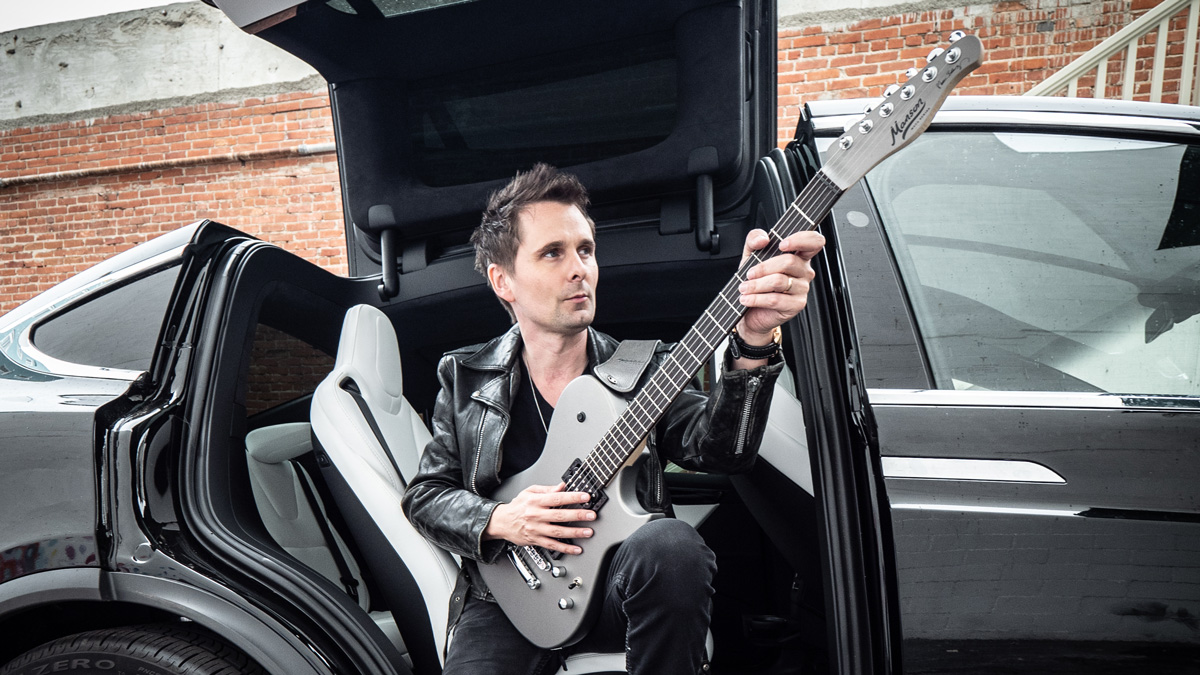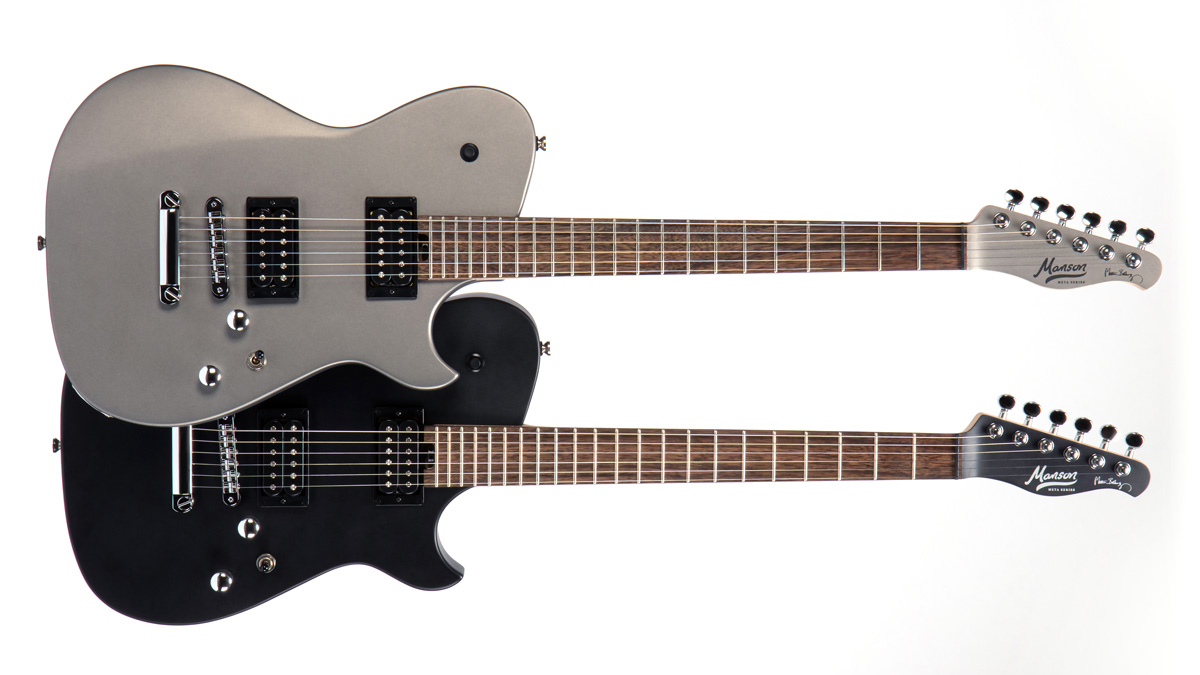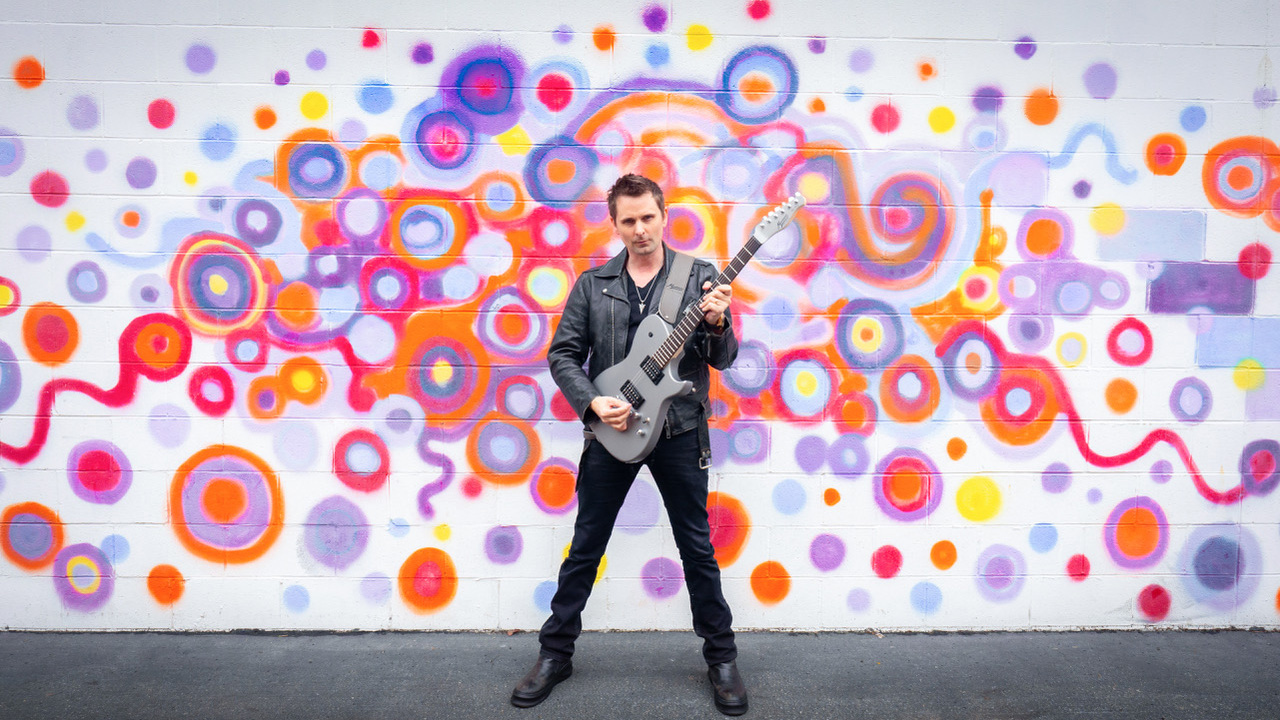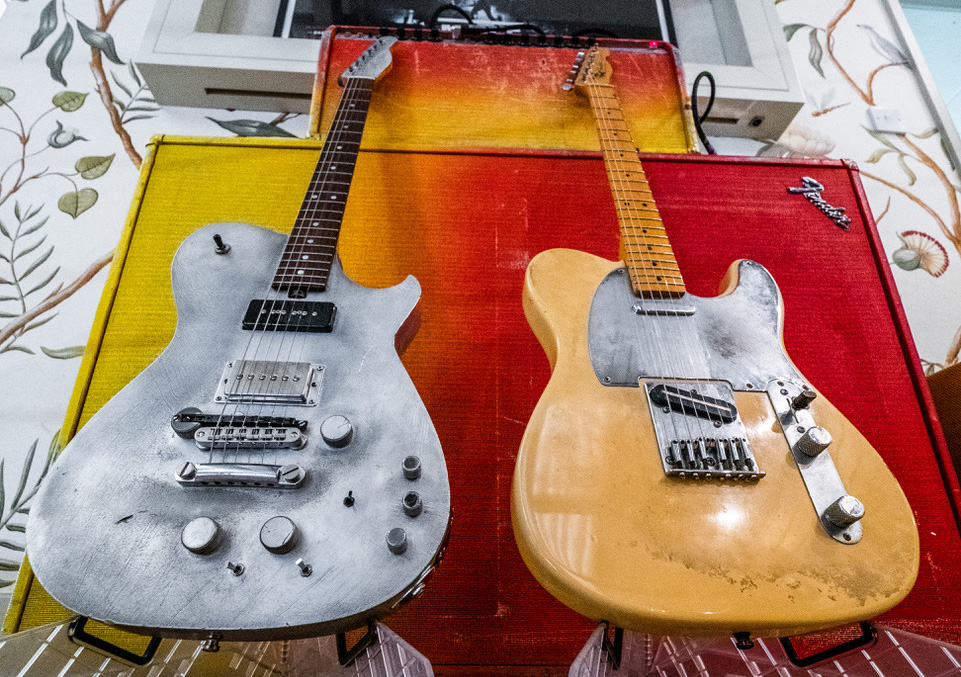Matt Bellamy: “As long as the guitar can keep up with making interesting sounds, it will always remain relevant”
The Muse frontman in-depth on Tom Morello’s unending inspiration, buying Jeff Buckley’s Telecaster, and how Manson guitars will be at the forefront of guitar’s evolution

2020 may be a year off for Muse, but life in quarantine could hardly be considered a vacation for Matt Bellamy, one of the 21st century’s bona fide guitar heroes.
The frontman’s home studio has been busier than ever, hosting recording sessions for his debut solo outing - symphonic piano overture Tomorrow’s World - as well as tracking and production work for The Jaded Hearts Club, his Beatles-themed supergroup with Graham Coxon and Miles Kane. But a return to his arena-demolishing day job will just have to wait for now.
“We’re going to get musical and get back in the studio probably next year for another album,” he reveals. “And we were hoping to do a tour, if the world comes back to any normality - probably in 2021 or 22.”
When Bellamy does eventually get back on stage, you can be sure of one thing: there will be a Manson custom guitar slung around his shoulder.
Back in June last year, Bellamy became the majority shareholder in his local guitar company, which has been bringing his technologically advanced guitar designs to life for the best part of 20 years.
Over the past year, the firm has launched the affordable META Series of Matt Bellamy signature models, while developing big plans for the future and how to cater for the guitarists of tomorrow - all with the Muse frontman’s visionary spirit at the helm.
We caught up with Bellamy to get all the info on what Manson is working on behind the scenes, why Tom Morello continues to be a key influence on his approach to guitar design, and how, exactly, he came to own Jeff Buckley’s iconic Fender Telecaster…
Get The Pick Newsletter
All the latest guitar news, interviews, lessons, reviews, deals and more, direct to your inbox!
What do you think sets Manson apart from other guitar companies, and what are your aims for the company?
We’ve got our eye on what guitarists might want in the future, not just trying to recreate what guitarists had in the past
“I think they’ve always been very open to my ideas to try and modernize the guitar and keep it up-to-date. Since we started making guitars together, we’ve tried to integrate effects and other sounds into guitars.
“I feel like we’re a future-leaning guitar company - we’ve got our eye on what guitarists might want nowadays and in the future, not just trying to recreate what guitarists had in the past. Rather than ‘the great vintage tone’ and all that kind of thing, I’ve always been more interested in ‘what’s a more modern sound?’ and ‘what kind of sound effects would fit in more with modern music?’
“And obviously it’s personal to me as well, because it’s a small business in Devon [UK], which is where I’m from. So, where the factory is and all that stuff, it’s just down the road from where I went to school.”
So, what guitars are next in the pipeline?
“We’ve just launched the Manson META series, which is like our equivalent of the Fender Squier-type thing. In other words, we wanted to create a low-cost model. We did it in the past with Cort, but now it’s very much our branding - we approve it, we put the electronics in, we distribute it, and all that kind of stuff. That’s pretty much based on my standard touring guitar, but there are hopefully a few other colors of that coming out as well.
“In terms of other, more higher-end, interesting things that we’re working on, I’ve been doing guitars with [Korg] Kaoss Pads in for a while, and some of the feedback we’ve got from people who have bought those is that sometimes they didn’t realize that you actually have to take MIDI out of the guitar and put it into a Kaoss Pad or a synthesizer, or some other MIDI-controlled device. So I’ve been very keen to try and develop a guitar where out of the box with a Kaoss Pad, it does cool stuff - you don’t need to actually attach it to anything else.

“What I’ve worked on is a long way from being in production - I’ve had one made for me that I have on tour, but obviously a lot of labour-intensive hours went into it, so it’s not quite cost-effective to actually make it saleable yet.
“If you look up the tour that I did last year - the guitar solo in the song Break It To Me has the kind of effect that I’m talking about. It’s the electronics and components from a [DigiTech] Whammy pedal, and all of those components are built into the guitar, along with a Kaoss Pad screen.
“So, essentially, it’s a guitar that has a really customizable Whammy scenario - so instead of using a whammy bar, you’re using the Kaoss Pad, so you can do anything from pitching up an octave, down an octave, two octaves up, two octaves down - you can even do divebombing, or you can do touch rhythmic playing.
“That’s the guitar that I’m most excited about trying to get it to the point where we can actually sell it and make it available. At the moment, it takes about a month or two just to build one of them. So I’m hoping to get that out, because to me, that’s a real evolution and a step beyond what the whammy bar was in the 20th century. I think, nowadays, you can do a lot more with this.”
![Muse - Break It To Me [Live at Hipódromo de Palermo, Buenos Aires 2019] - Pro-Shot (1080p) - YouTube](https://img.youtube.com/vi/XeYwwpoVYTg/maxresdefault.jpg)
Speaking of guitar’s place in the 21st century, you’ve stated that guitar is no longer a lead instrument - do you still stand by that statement, and how does that feed into the guitars that Manson makes?
“[Laughs] I can’t remember exactly what I said, but I think what I meant was I think that unless a guitar is a lead instrument. I think in the 20th century, the guitar could exist just as a rhythm instrument, just in the background, strumming along, playing powerchords or whether it be rhythmic chords on acoustic guitar or whatever.
“I kind of feel the guitar as a rhythm instrument is not as important as it used to be. But I think the guitar as a lead instrument, playing cool, big melodies, or doing something that when it happens in a song, you go, ‘Oh my god, there’s a guitar!’ and you can hear it doing something really important. Like a big riff, or a cool lead melody, or even a solo or whatever, I still think all that stuff is very much important and relevant to modern music. And obviously the acoustic guitar has stayed very important.
“I think what I meant by that was just strumming along doing powerchords is no longer enough for the guitar to be an exciting instrument, especially in contemporary music.”
Where do you think the future of guitar lies?
The guitar has always remained so exciting because you can run around on stage - you can still be a frontman or woman, and you can still play musical notes as well
“I think it probably lies there. All music consists of some kind of element of a riff or a melody of some kind. I don’t just mean guitar-based - whether it be a piano, a synth or even a vocal lick or something. A good composition always seems to have really interesting melodies, or riffs or licks or catchy parts, however you want to call it.
“I think as long as the guitar can keep up with making interesting sounds, it will always remain relevant in that way. Because in terms of a performance instrument, I do think it does feel the best. I play piano, I play keys and stuff like that, but when I’m onstage, it feels restricted, you don’t feel like you can run around - I don’t feel like I can do much.
“With contemporary music, you’ve got a lot of people that have something on a laptop in the background, and then they have an interesting frontperson who runs around. But the guitar is the only instrument that really bridges that gap - you can actually be a frontperson playing an instrument.
“I think that’s why the guitar has always remained so exciting: because you can run around on stage, you can still be a frontman or woman, and you can still play musical notes as well. There aren’t really many instruments that have been able to give that freedom - whether it be drums, laptops, keyboards, you are restricted to a seat or a standing position mostly. Unless you want to get the keytar out... but I’m not sure about the keytar! [laughs]”
You’ve had some instruments that have been very close…
“I know, I know... I’ve dabbled! [laughs]”

So, apart from the technological aspects, what do you think are the most important elements of a good guitar?
“Some of the things that I’ll say are probably a bit more about the fact that I’m a frontman running around - so, for me, I think guitars that sound good but are very lightweight. I’m not a fan of big heavyweight guitars, but that’s more of an onstage thing.
“In the studio, it’s almost the opposite - you want something that’s got a nice, woody tone so that when you’ve got a clean sound, it has an element of character to it... elements of imperfection, you know what I mean?
“I think sometimes some modern guitars can lean too far in the ‘totally clean, even tones across every note [territory]’, to the point where it loses a little bit of character. So I’ve often played a lot with putting different pickups in my guitars - especially for studio use - that have a little bit more of a slightly crunchier tone, or a slightly more imperfect feel about them.
For me, I had to make a guitar that was brand-new in order to feel like everything I’m doing on it is gonna take me in a new direction
“But it has to be something that feels good to you. I’d say probably the most important thing is that when you pick it up, you feel like you are you; you’re not just trying to be someone else. It’s a cheesy maxim, but essentially [adopts American accent] be yourself, man. [laughs]
“But what I mean by that is, for me, that was a very real thing insomuch as, to this day, if I’m playing a Strat or whatever, I play the blues. The blues just starts coming out. I can’t stop playing the blues on a Strat!
“So, whatever style of music you’re in - or whatever style of music you want to do, or whatever you identify with yourself as an artist - make sure you’ve got the guitar that makes you feel like that’s what you’re gonna do, and it doesn’t pull you in another direction.
“For me, I had to make a guitar that was brand-new in order to feel like everything I’m doing on it is gonna take me in a new direction, and not make me feel like I’m replicating music from the past.”
Tom Morello adopts a similar ethos - he recently supported you on tour and you gave him his own custom-made Manson model. That must have been pretty surreal, given what a huge influence he was on Muse…
“Yeah, he’s a great guy. I’d say he’s been really influential on my concept of guitars as well. We mentioned that whole Whammy thing - a lot of that stems from some of his playing in the ’90s, and how he used the Whammy pedal.
“A lot of it was me watching him, going, ‘How could he be doing this in a way that he wasn’t stood just in front of his pedalboard? What if he wanted to go out into the crowd, or what if he wanted to walk around the stage and do some similar stuff?’ So my thinking was, ‘What could we do to make guitar work for someone without having them in a fixed position on stage?’
“I think he’s probably the most innovative guitarist of our generation. So I felt like I had to give him something to say thanks for all the amazing riffs.”
A post shared by Matt Bellamy (@mattbellamy)
A photo posted by on
You’re not looking to sign him up as a signature artist, are you?
“[laughs] I dunno… maybe! I’m not sure if he’s into that kind of thing. I mean, that’s a good idea… I think at some point I would want to expand out and get some other people involved - get some other guitarists to do signature models - and he would certainly be top of my list, that’s for sure.”
Manson is best known for its solidbody T-types. Do you see the company moving into other styles of guitars?
“For sure, yeah. To me, it feels like it’s leaned slightly metal, slightly hard-rock, and very modern. But having said all that stuff about being modern - it’s weird that I said all that, because I’m now about to say the exact opposite. [laughs]
Graham Coxon from Blur and I are gonna work on a really interesting vintage type of guitar
“One of the things we are looking at is a collaboration with Graham Coxon from Blur, and we’re gonna work on a really interesting vintage type of guitar. It won’t be a vintage-looking guitar, but the tonality of it is gonna be very much the whole hand-wound pickups and all that kind of stuff. So that’s something that is actually very different for the company - it’s very different to everything that I’ve done with the company. It’s very different to any of the guitars that I play. But we are looking to tap into the vintage sound a little bit. That will be a line we do on the side.
“I’m looking to do a bass at some point. I’ve got myself a little band I’m doing called The Jaded Hearts Club, which is fun, and I play the bass in that band. I’ve actually been developing a cool bass, which is based on the Hofner bass that Paul McCartney played, but it’s obviously going to be a much more modern-looking and sounding version of that as well - I like the idea of expanding the bass range a little bit.
“Obviously, I’m a smaller bloke; when I play bass, I’m similar to Mike Kerr from Royal Blood in terms of the shorter-scale, more lead-type bass playing. In other words, bass playing where you’re playing lead riffs, not just bottom-end stuff. So I’m trying to develop a bass that has that kind of feel to it.
“Another thing we’re doing - it might be this year or next year - is an exact replica of my favorite [the Black Manson], and the first Manson guitar that I ever had made [the Delorian], which was 20 years ago. So we might do a limited run of a really precise, exact replica, including all of the electronics from that time.
“This stuff is probably at least six months or a year away, but I’m starting to look at effects pedals, as well. So we might develop a few interesting delays and fuzzes.”

Have you ever had any ideas so crazy, the guys at Manson just said, ‘Nope - that’s impossible’?
“[Laughs] Honestly, they’ve been very, very open. They made a version of the double-neck guitar, but originally I wanted the six strings to essentially be a ribbon controller MIDI thing, so in other words, like the bend on a MIDI.
“One neck was a fretless MIDI controller that could send bending notes on a sustained note. So, that was a real headache - it took about two years to make, and ended up with a compromised version of what I was looking for.
“But pretty much everything I’ve come up with, they’ve been generally pretty good. I keep trying to cram so much electronics into a guitar that it’s too much than can fit into the body. So, I’m hoping that as technology gets smaller and smaller, I can hopefully get as much stuff in there as possible, so the guitar itself can function without needing any outboard gear in terms of MIDI stuff and synthesizers and all those kinds of things.”
And, finally, what was your last great gear discovery?
“Well, I’ve gotta say, I just bought Jeff Buckley’s guitar that he used to record the Grace album. I’m not kidding! I had a whole team of people doing due diligence on it to make sure it was absolutely the right one, interviewing his family and all sorts. I managed to get it verified, and I’ve got his Telecaster that he used to record the whole Grace album and the song Hallelujah.
“It’s interesting, because he was a huge influence on me as a vocalist, but he was actually a great guitarist as well, and obviously Hallelujah is a legendary recording. I haven’t bought it to hang it on the wall with a picture of Jeff saying, ‘Look what I’ve got.’ I’ve bought it to actually attempt to use it and integrate it, and keep this guitar part of music. I’d like to believe that’s what he would have wanted.
“But what’s fascinating about the guitar is its sound. It sounds so weird - it doesn’t sound like any other Telecaster. I’ve had all the electronics analyzed - nobody’s changed anything - but the pickups, they think the neck pickup was a mistake by the manufacturer because for some reason it’s slightly out-of-phase, and they’re also saying there’s something weird about the wiring. To cut a long story short, it’s got an extremely glassy, bright sound, and it doesn’t really sound like any other guitar I’ve used before.
“I’ve already used that, actually. It’s on a cover song that we’re doing with the Jaded Hearts Club. But I’m hoping to use that a little bit here and there on the next Muse album as well. It’s amazing to have a bit of history like that, and to just feel a little bit of his greatness.”

Glad to hear it’s gone to a good home! Where did you track it down?
“I was doing an interview with a guitar magazine in France, and the guy that ran the guitar magazine brought his friend in, who’s a vintage guitar collector called Matt [Lucas], and he wanted to surprise me midway through the interview, and show me that guitar. I guess he wanted to capture it on the interview - ‘Oh, what’s your reaction to this? And how’s it feel?’ and all that kind of stuff.
I’m trying to adhere to the letter she wrote to make sure it gets some play. The only problem is I don’t think I’ve written any songs good enough to play it on yet!
“At that time, I said to the guy, ‘If I can ever use it or whatever, let me know.’ I didn’t hear from the guy, and that was at least two or three years ago. And then out of the blue, about six months ago, he contacted me and said, ‘Oh, by the way, I am maybe looking to move this guitar on, if you’re interested.’
“Obviously, at that point, we had a lot of talks about where it came from, and all the background, and he’s even got a letter from Jeff’s best friend at the time, who’s a girl who lived in New York [Janine Nichols]. It was actually her guitar - Jeff didn’t have a really good guitar at the time [Buckley’s apartment had been robbed around this period in 1991], and when he started touring, she lent this Telecaster to him.
“He used it for all of his touring and his recording at that point, and then when he sadly passed away, she got it back. She kept it for 10, 15 years or so. Then, eventually, she passed it on, and she wrote a long letter with the guitar, saying she really wanted it to go to someone who’s actually going to play it, not just put it on the wall. So that’s what I’m doing - I’m trying to adhere to the letter she wrote to make sure it gets some play.
“The only problem is I don’t think I’ve written any songs good enough to play it on yet! [laughs] So the pressure’s now on.”
So, it’s safe to say it’s a studio rather than a live guitar?
“I think so, yeah - maybe one day I’ll bring it out for something, but we’ll see.”
For more info on the META Series, and the company’s future guitars, head over to Manson Guitar Works.

Mike is Editor-in-Chief of GuitarWorld.com, in addition to being an offset fiend and recovering pedal addict. He has a master's degree in journalism from Cardiff University, and over a decade's experience writing and editing for guitar publications including MusicRadar, Total Guitar and Guitarist, as well as 20 years of recording and live experience in original and function bands. During his career, he has interviewed the likes of John Frusciante, Chris Cornell, Tom Morello, Matt Bellamy, Kirk Hammett, Jerry Cantrell, Joe Satriani, Tom DeLonge, Ed O'Brien, Polyphia, Tosin Abasi, Yvette Young and many more. In his free time, you'll find him making progressive instrumental rock under the nom de plume Maebe.
“There’d been three-minute solos, which were just ridiculous – and knackering to play live!” Stoner-doom merchants Sergeant Thunderhoof may have toned down the self-indulgence, but their 10-minute epics still get medieval on your eardrums
“There’s a slight latency in there. You can’t be super-accurate”: Yngwie Malmsteen names the guitar picks that don’t work for shred


![A black-and-white action shot of Sergeant Thunderhoof perform live: [from left] Mark Sayer, Dan Flitcroft, Jim Camp and Josh Gallop](https://cdn.mos.cms.futurecdn.net/am3UhJbsxAE239XRRZ8zC8.jpg)







